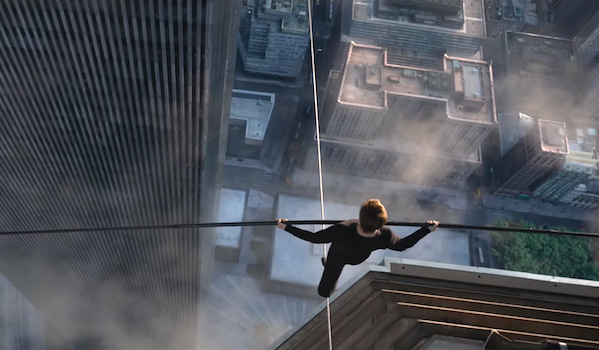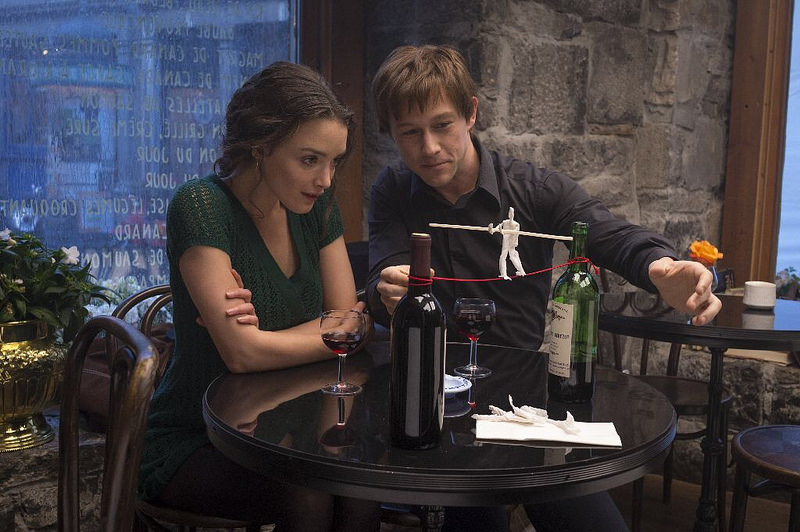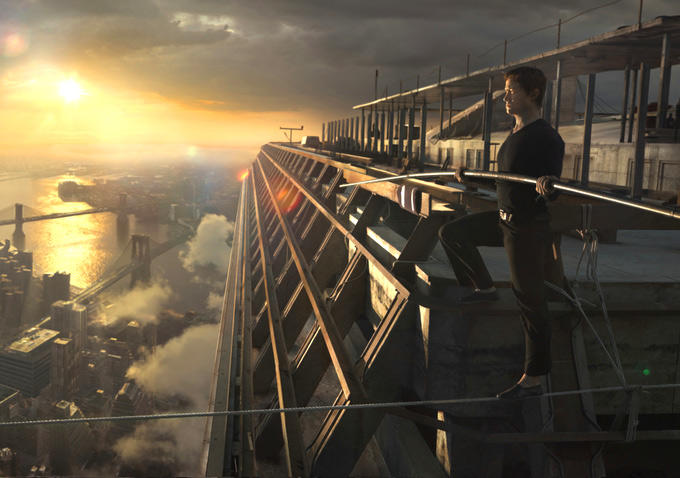The Walk (2015)
CAST: Joseph Gordon-Levitt, Ben Kingsley, Charlotte Le Bon, James Badge Dale, Steve Valentine, Clement Sibony, Cesar Domboy
REVIEW:
During their twenty-eight-year lifespan, New York City’s iconic Twin Towers were host to their share of newsworthy occurrences, including a 1993 terrorist bombing that did fairly little damage but in hindsight would serve as foreshadowing of their eventual demise. A more uplifting (albeit death-defying) incident, and one of the most amazing spectacles they or any other building in the world had ever seen, came when the towers were still under construction, on the morning of August 7, 1974, when a French high-wire walker named Philippe Petit spent approximately forty-five minutes walking back-and-forth on a 200 foot cable suspended 1,370 feet above the ground, without benefit of net or safety harness. Petit’s audacious stunt got him arrested (though he faced only a slap on the wrist), but also made him at least briefly an international celebrity and helped make the new Twin Towers icons in their own right (before Petit’s stunt, many New Yorkers disliked the new towers, considering them oversized eyesores that towered over the city and blocked the sun, but Petit’s walk helped usher in their status as iconic NYC landmarks). Petit’s walk was already the subject of a 2008 documentary, Man on Wire, directed by James Marsh and narrated by Petit himself, and now Robert Zemeckis has brought the story back to the big screen as The Walk, working off of Petit’s memoirs “To Reach The Clouds”. While it’s debatable whether The Walk really brings anything new to the table that can’t be gleaned from Man on Wire (apart from recreating the titular walk through state-of-the-art technical wizardry), it serves as an entertaining and engaging, albeit flawed, docudrama and a love letter to not only Philippe Petit, but the towers he crossed.
In 1973 Paris, Philippe Petit (Joseph Gordon-Levitt) is a flamboyant and charismatic street performer who juggles, wire-walks, and mimes for crowds of onlookers. But Petit has far bigger ambitions. One day, a chance glance at a newspaper article detailing the nearly-completed construction of New York City’s Twin Towers (at the time, the tallest buildings in the world) catches Petit’s eye, and he becomes unshakably determined to perform what he calls his “coup”: pulling off the greatest stunt the world has ever seen by walking a wire between the two 110-story buildings. To this end, he seeks out the advice of his mentor “Papa” Rudy (Ben Kingsley), the patriarch of a family of circus high-wire acrobats, and assembles a team of both French and American accomplices, including his fellow street performer and girlfriend Annie (Charlotte Le Bon), his “official photographer” Jean-Louis (Clement Sibony), fellow Frenchman “Jeff” (Cesar Domboy), who’s afraid of heights, and eccentric Americans J.P. (James Badge Dale), who hooks the team up with walkie-talkies, and Barry Greenhouse (Steve Valentine), their “inside man” who works at the World Trade Center, along with a pair of unreliable stoners (Ben Schwartz and Benedict Samuel). Since Petit’s stunt is not only highly dangerous but highly illegal, he devises elaborate ruses to smuggle himself and his compatriots into the towers, including impersonating architects and construction workers. Finally, after complicated preparations, dawn breaks on August 7, 1974, and the city looks skyward to witness something none of them had ever seen before.
 The Walk has a clearly delineated first, second, and third act. The first, which is the longest and most sluggish, sketches out Petit’s background, his meeting with his mentor Papa Rudy, his “meet cute” with girlfriend Annie, his early small-time antics as a mime, juggler, and wire-walker (he starts out stringing up a wire between trees in his childhood backyard, to the exasperation of his parents, and graduates up to streetlights and later the Notre Dame cathedral). The pace picks up in the second act, as Petit comes to America and assembles his “accomplices”, and the movie takes on the tone of a heist caper. There’s a tongue-in-cheek sense of humor running throughout (the movie opens with, and periodically cuts back to, Petit narrating cheekily into the camera while perched atop the flame of the Statue of Liberty, his beloved towers looming large in the background). The Walk‘s two main flaws are most prominent in these earlier scenes. Zemeckis dabbles too deep in precious whimsy, with the affectations of starting out in crisp black-and-white in a romanticized 1973 Paris, and the narrative device of Gordon-Levitt’s “talking head” narration from his perch atop the Statue of Liberty. It’s the kind of cutesy movie that kicks off with our oh-so-French hero riding a unicycle down a stereotypical Parisian street full of cafes occupied by people eating bagels and the Eiffel Tower looming large in the background looking straight off a postcard, while a soundtrack of 1970s greatest hits plays in the background, and people say painfully earnest things like “your heart will tell you what to do”. Gordon-Levitt’s neverending narration is an irksome point that continues unabated through the entire runtime. I prefer movies that don’t feel the need for a running narration to basically spell every scene out for us, and too often that’s exactly what The Walk does. The narration occasionally gives us insights into the operation or Petit’s mentality, but too often, it’s simply describing things we can glean for ourselves from the scenes as they happen. The third act, expectedly is “The Walk” itself. While it doesn’t play out in real time (the sequence lasts about twenty minutes instead of the real-life forty-five), it’s long enough, and includes historically accurate details like Petit continually taunting the police awaiting him on both towers by coming within a few steps of the ledge, then spinning around without losing his balance and walking back the other way, at other points bowing to his swelling audience of onlookers far below, kneeling atop the precariously narrow wire, and even laying flat on his back. Joseph Gordon-Levitt trained with the real Petit while preparing for the role, and performed his own wire-walking (albeit actually a short distance above the ground, not 1,370 feet in the air). Considering the Twin Towers, which play a central role in the proceedings, are no longer existent in reality, there is plenty of special effects trickery in The Walk, but (apart from a couple instances of dodgy green screen early in the movie, before we even get to the Towers) Zemeckis blends practical effects and CGI together indistinguishably to recreate Petit’s walk with eerie verisimilitude. At no point in time do the towers look like anything less than their real selves, and the uncanny recreation occasionally lends the fairly lighthearted The Walk an underlying poignancy. It’s hard or impossible to watch The Walk without having at least fleeting thoughts of 9/11, even if the story onscreen took place 28 years earlier. There were reports of some viewers suffering from vertigo and even panic attacks while watching this sequence in the theater, and it’s possible to see why, especially if viewed in the more immersive 3D format the movie was heavily promoted in. At points during the walk, the camera swoops dizzyingly down, giving the effect of plunging straight at the ground and zooming in on the crowds who are mere dots from Petit’s perspective. An earlier scene, in which Petit cranes his neck to gaze up at the towers, reminds us that it’s possible to suffer vertigo even looking up at a great height from below.
The Walk has a clearly delineated first, second, and third act. The first, which is the longest and most sluggish, sketches out Petit’s background, his meeting with his mentor Papa Rudy, his “meet cute” with girlfriend Annie, his early small-time antics as a mime, juggler, and wire-walker (he starts out stringing up a wire between trees in his childhood backyard, to the exasperation of his parents, and graduates up to streetlights and later the Notre Dame cathedral). The pace picks up in the second act, as Petit comes to America and assembles his “accomplices”, and the movie takes on the tone of a heist caper. There’s a tongue-in-cheek sense of humor running throughout (the movie opens with, and periodically cuts back to, Petit narrating cheekily into the camera while perched atop the flame of the Statue of Liberty, his beloved towers looming large in the background). The Walk‘s two main flaws are most prominent in these earlier scenes. Zemeckis dabbles too deep in precious whimsy, with the affectations of starting out in crisp black-and-white in a romanticized 1973 Paris, and the narrative device of Gordon-Levitt’s “talking head” narration from his perch atop the Statue of Liberty. It’s the kind of cutesy movie that kicks off with our oh-so-French hero riding a unicycle down a stereotypical Parisian street full of cafes occupied by people eating bagels and the Eiffel Tower looming large in the background looking straight off a postcard, while a soundtrack of 1970s greatest hits plays in the background, and people say painfully earnest things like “your heart will tell you what to do”. Gordon-Levitt’s neverending narration is an irksome point that continues unabated through the entire runtime. I prefer movies that don’t feel the need for a running narration to basically spell every scene out for us, and too often that’s exactly what The Walk does. The narration occasionally gives us insights into the operation or Petit’s mentality, but too often, it’s simply describing things we can glean for ourselves from the scenes as they happen. The third act, expectedly is “The Walk” itself. While it doesn’t play out in real time (the sequence lasts about twenty minutes instead of the real-life forty-five), it’s long enough, and includes historically accurate details like Petit continually taunting the police awaiting him on both towers by coming within a few steps of the ledge, then spinning around without losing his balance and walking back the other way, at other points bowing to his swelling audience of onlookers far below, kneeling atop the precariously narrow wire, and even laying flat on his back. Joseph Gordon-Levitt trained with the real Petit while preparing for the role, and performed his own wire-walking (albeit actually a short distance above the ground, not 1,370 feet in the air). Considering the Twin Towers, which play a central role in the proceedings, are no longer existent in reality, there is plenty of special effects trickery in The Walk, but (apart from a couple instances of dodgy green screen early in the movie, before we even get to the Towers) Zemeckis blends practical effects and CGI together indistinguishably to recreate Petit’s walk with eerie verisimilitude. At no point in time do the towers look like anything less than their real selves, and the uncanny recreation occasionally lends the fairly lighthearted The Walk an underlying poignancy. It’s hard or impossible to watch The Walk without having at least fleeting thoughts of 9/11, even if the story onscreen took place 28 years earlier. There were reports of some viewers suffering from vertigo and even panic attacks while watching this sequence in the theater, and it’s possible to see why, especially if viewed in the more immersive 3D format the movie was heavily promoted in. At points during the walk, the camera swoops dizzyingly down, giving the effect of plunging straight at the ground and zooming in on the crowds who are mere dots from Petit’s perspective. An earlier scene, in which Petit cranes his neck to gaze up at the towers, reminds us that it’s possible to suffer vertigo even looking up at a great height from below.
The Walk maintains a fairly lighthearted tone throughout, and there’s a feeling the filmmakers play it safe and skim over or barely scratch the surface of some aspects to retain the “inspirational” mood they were obviously aiming for. Despite donning blue contact lenses and a wig to match Petit’s eye and hair color, there’s no real resemblance between Joseph Gordon-Levitt and the real Philippe Petit (like many actors playing real people, Gordon-Levitt is much better-looking), and the movie softens his edges. The movie’s Petit is allowed to have some flaws—he’s an obsessive, erratic showboat who’s sometimes careless of the way he treats those around him—but the movie completely omits the real Petit’s behavior in the aftermath of his stunt (flushed with newfound fame, he abandoned his loyal girlfriend to have a one-night stand with a random admirer who approached him on the street), and through a combination of the generally lighthearted tone and Gordon-Levitt’s boyish plucky charms, the movie’s Petit comes off, for the most part, as an eccentric but charming rapscallion (we get one obligatory scene two-thirds of the way through where Annie is allowed to have an outburst calling Philippe out on all his negative qualities, but the movie glosses over the reasons behind the two parting ways in the epilogue).
 While one could argue the real “stars” of The Walk are the Twin Towers themselves, Joseph Gordon-Levitt does a solid job capturing the real Petit’s blend of charm, quirkiness, manic energy, and almost fanatical determination. Gordon-Levitt is a charismatic and engaging enough screen presence to help keep the movie afloat through its less riveting segments. In addition to donning a French accent, Gordon-Levitt (a real-life fluent French speaker) also speaks subtitled French in various scattered snatches of dialogue, and is physically graceful enough to reenact Petit’s lightfooted stunts (or at least to fake it convincingly). The rest of the characters are thinly-drawn. Ben Kingsley’s indeterminately-accented Papa Rudy is a standard-issue crotchety mentor whose relationship with Petit is sometimes tumultuous, sometimes fatherly. Likewise, French-Canadian actress Charlotte Le Bon has some chemistry with Gordon-Levitt (their “meet cute” is playfully flirtatious), but limited to the thankless role of the supportive girlfriend. Of the “accomplices”, only Steve Valentine sticks out, and that’s only because of his eccentric facial hair.
While one could argue the real “stars” of The Walk are the Twin Towers themselves, Joseph Gordon-Levitt does a solid job capturing the real Petit’s blend of charm, quirkiness, manic energy, and almost fanatical determination. Gordon-Levitt is a charismatic and engaging enough screen presence to help keep the movie afloat through its less riveting segments. In addition to donning a French accent, Gordon-Levitt (a real-life fluent French speaker) also speaks subtitled French in various scattered snatches of dialogue, and is physically graceful enough to reenact Petit’s lightfooted stunts (or at least to fake it convincingly). The rest of the characters are thinly-drawn. Ben Kingsley’s indeterminately-accented Papa Rudy is a standard-issue crotchety mentor whose relationship with Petit is sometimes tumultuous, sometimes fatherly. Likewise, French-Canadian actress Charlotte Le Bon has some chemistry with Gordon-Levitt (their “meet cute” is playfully flirtatious), but limited to the thankless role of the supportive girlfriend. Of the “accomplices”, only Steve Valentine sticks out, and that’s only because of his eccentric facial hair.
At the bottom line, The Walk offers little more than a docudrama reenactment of the story already recounted equally informatively in Man on Wire, but with the added offering of a visceral visual recreation using state-of-the-art Hollywood magic that a documentary, as fascinating as it may be, cannot match (there is no real footage of Petit’s walk, only still photographs). Few would dispute this visual spectacle, not the sometimes generic narrative, is the strongest element of The Walk, and the strongest selling point for those who already find the straight documentary a sufficient telling of a remarkable true story.
* * *
